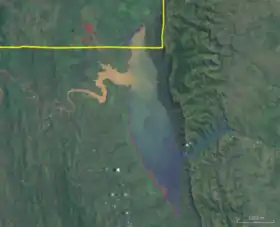Pongolapoort Dam
Pongolapoort Dam, commonly referred to as Lake Jozini, is an arch type dam (double-curvature single-arch[1]) in northern KwaZulu-Natal, South Africa located on the Phongolo River. The dam is situated 280 km north-east of the port city of Durban. The dam was constructed in 1973 at the eastern end of the narrow gorge separating the Lebombo and Ubombo ranges and was the largest dam in South Africa at the time of its construction. The dam mainly serves for irrigation purposes and its hazard potential has been ranked high (3). The Phongolo River is the dams largest feeder as well as the dams only perennial feeder.
| Pongolapoort Dam | |
|---|---|
 | |
| Official name | Pongolapoort Dam |
| Country | South Africa |
| Location | Northern KwaZulu-Natal |
| Coordinates | 27°24′08″S 31°57′31″E |
| Purpose | Irrigation |
| Opening date | 1973 |
| Owner(s) | Department of Water Affairs |
| Dam and spillways | |
| Type of dam | Arch dam |
| Impounds | Phongolo River |
| Height | 89 m |
| Length | 451 m |
| Reservoir | |
| Creates | Pongolapoort Dam Reservoir |
| Total capacity | 2 445 900 000 m3 |
| Catchment area | 7814 km2 |
| Surface area | 13 272.8 ha |
History
Prior to the construction of the Pongolapoort Dam the land was Africa's first formally recognised conservation area. The Pongola Game Reserve was proclaimed in 1894 by the then President of the Transvaal Republic Paul Kruger. This would ultimately lead to the proclamation of the Hluhluwe-Imfolozi, Mkuze and Ndumo Game Reserves as well as one of Africa's greatest wildlife conservation parks, the Kruger National Park.[2]
Wildlife
The dam is flanked by private wildlife reserves as well as the Pongola Game Reserve which has many private lodges as well campsite for fishing. Wildlife and birdlife abound in the area. Mammals to be sought include elephant, leopard, white and black rhinoceros, buffalo, hippopotamus, waterbuck, bushbuck, nyala, greater kudu, zebra, giraffe and spotted hyaena.
The dam and its surrounds support over 350 bird species which includes rarities such as African broadbill, saddle-billed and yellow-billed storks, African finfoot, Pel's fishing owl and Narina trogon. The dam also supports a breeding colony of pink-backed and great white pelicans. Additionally the dam supports a stable population of Nile crocodiles.
The dam is also home to the southernmost population of tigerfish. Other fish species include catfish and kurper.
Water quality
No information regarding the water quality of the dam but can be assumed to be fair. The Pongola Rivers major form of pollution is agricultural pesticides which make their way into the river due to the heavy use of land for agriculture above the dam.
See also
- List of reservoirs and dams in South Africa
References
- "Pongolapoort Dam: Development steeped in controversy" (PDF). Water Research Council. May 2009. Retrieved 9 Jan 2020.
- "Kruger Lodges". Retrieved 10 December 2015.